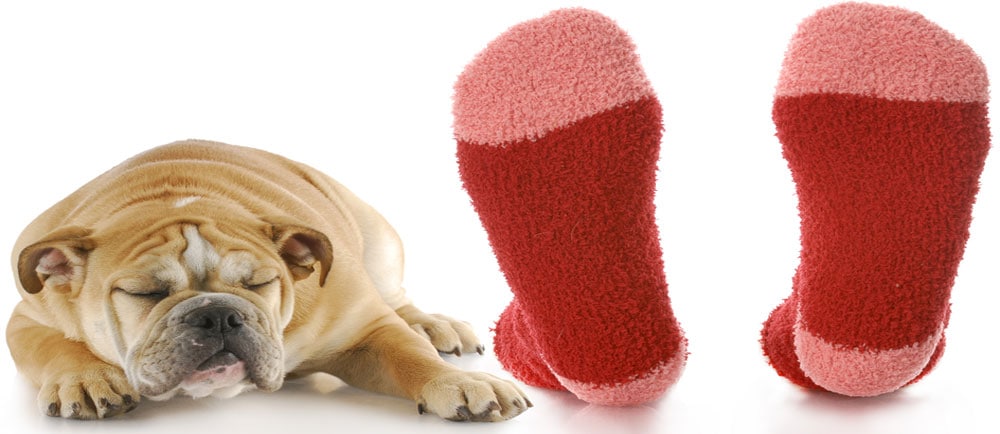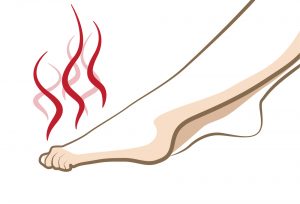
Does your dog turn his nose up and walk away when you get home from work and kick your shoes off? Does your partner, family, or roommate make you keep your gym shoes outside of the house? Are you panicked at the thought of taking off your sneakers in the locker room at your health club? Have you tried fungal powders and your feet still smell like a 2,000-year-old fermented egg?
If the answer to these questions is yes, your smelly feet might be due to a common bacterial skin infection called Pitted Keratolysis.
An introduction to Pitted Keratolysis (PK)
Pitted Keratolysis (PK) appears as smelly whitish skin on the soles of the feet, or (rarely) on the palms of the hands, with clusters of tiny punched-out pits that are more noticeable when the skin is wet. Sometimes these superficial erosions coalesce into what looks like a small crater on the plantar surface of your foot.
The most notable symptom of PK is the malodor that’s produced by any one of several bacteria which destroy the skin’s outermost layer (known as the stratum corneum) causing pitting. The bad smell comes from sulfur compounds released by the bacteria as it breaks down your skin.
The most common culprits are bacteria with names that sound like they come from the Seven Kingdoms: Corynebacteria, Dermatophilus congolensis, Kytococcus sedentarius, Actinomyces, and Streptomyces. These nasty buggers multiply in wet or moist conditions, so people who don’t let their feet air out enough often fall prey to them.
This condition can affect both sexes, although men outnumber women seven to one,1 especially those who wear closed shoes and spend time in hot, humid conditions such as athletes, farm workers, fishermen, industrial workers, and military personnel.
Others at risk for developing PK are folks with excessive sweating of the palms and feet (a condition called hyperhidrosis), diabetics, the elderly, and persons with immunodeficiency.
So how do you know if you have Pitted Keratolysis?
The only way to know if you have PK is to visit your doctor. He or she will take a swab or scraping of the superficial layer of your skin surface and look at it under a microscope to confirm your diagnosis.
Now the good news: there is a cure for smelly feet

That’s right. Once your diagnosis is confirmed, your days of being sent to wash your feet before going to bed or facing banishment to the guest room are numbered! Did you know that couples that sleep together actually share the bacteria on their feet? Ew…
PK can be cured with a four-week course of topical antibiotic gel or cream and antiseptics such as benzoyl peroxide or fusidic acid. Sometimes, your doctor might even prescribe oral erythromycin.
Folks who have a problem with hyperhidrosis, know that it can be treated with botulinum toxin injections (yes, that Botox). The effectiveness of home remedies such as vinegar and tea tree oil have not been formally studied, so we can’t recommend them.2
How to get rid of smelly feet once and for all
Because the stink-causing bacteria breed in dark, moist environments, it’s important for you to make sure that your feet stay clean and dry. This means:
- wearing boots or closed shoes for as short a time as possible, opting instead for open-toed sandals whenever possible
- avoid wearing the same shoes two days in a row to let them dry out
- wearing cotton or wool socks that absorb sweat well
- washing your feet twice daily with soap or antiseptic cleanser
- applying antiperspirant to your feet at least twice weekly
- avoid sharing footwear or towels
Keeping your feet clean and dry will keep the nasty bacteria away and your feet smelling a whole lot better. Your family and friends will stop banishing you to the room next door and, who knows? Maybe your dog will go back to being your best friend!
Why choose University Foot and Ankle Institute for your foot and ankle care?
The physicians of University Foot and Ankle Institute have decades of successful experience diagnosing and treating toenail fungus. Our nationally recognized foot and ankle specialists offer the most advanced podiatric care and the highest success rates in the nation. We are leaders in the research and treatment of all foot and ankle conditions.
For more information or to schedule a consultation, please call (877) 736-6001 or visit us here to make an appointment online.
We are conveniently located throughout Southern California and the Los Angeles area as our foot doctors are available at locations in or near: Santa Monica (on Wilshire Blvd.), Beverly Hills, West Los Angeles, Manhattan Beach, Northridge, Downtown Los Angeles, Westlake Village, Granada Hills, and Valencia, California.
- https://www.dermatologyadvisor.com/home/decision-support-in-medicine/dermatology/pitted-keratolysis-keratolysis-plantare-sulcatum-keratolysis-sulcata-plantar-keratolysis-sulcatum-keratolysis-punctata-sulcate-plantare-keratolysis/
- https://www.healthline.com/health/pitted-keratolysis#treatment
- What To Do When Your Toenail Is Falling Off - October 21, 2024
- How To Tell If You Have Wide Feet - October 3, 2024
- 15 Summer Foot Care Tips to Put Your Best Feet Forward - July 1, 2024
Leave a Reply